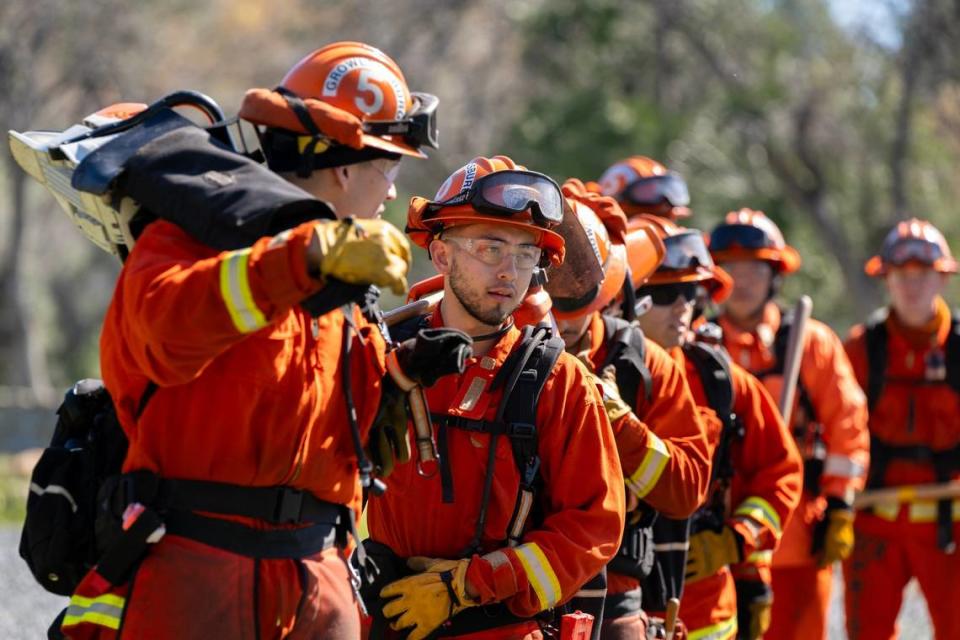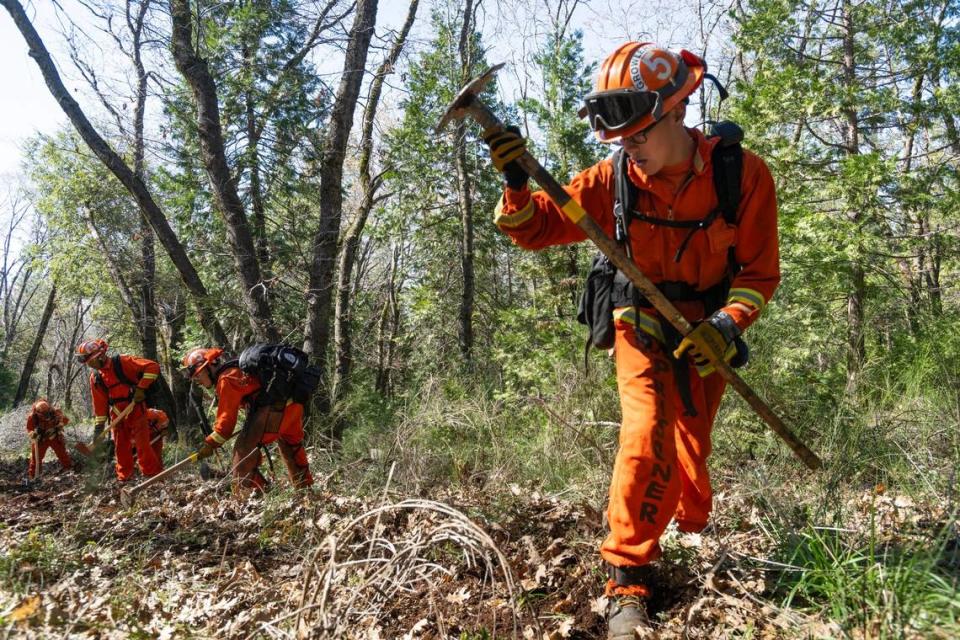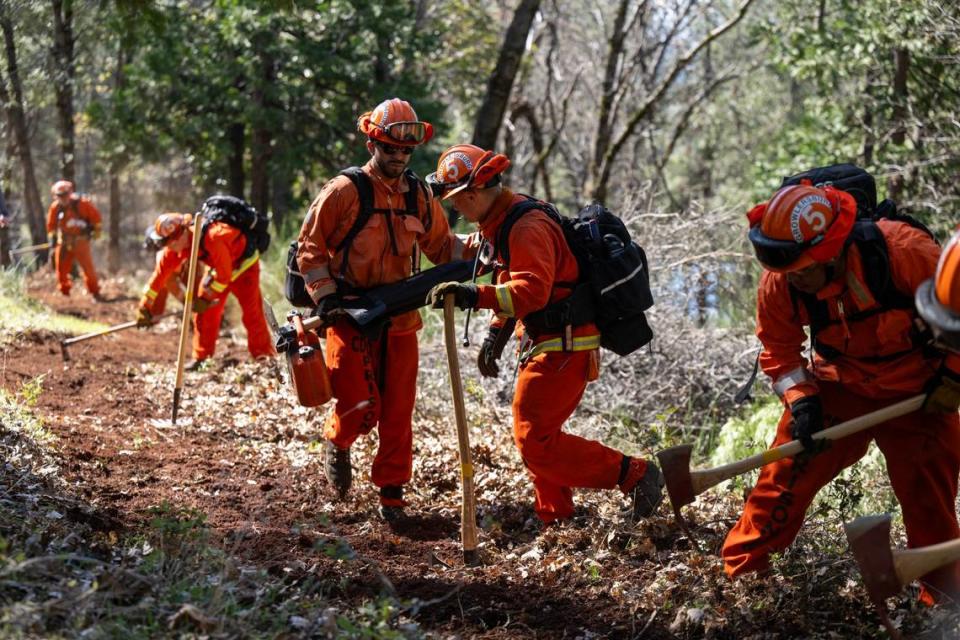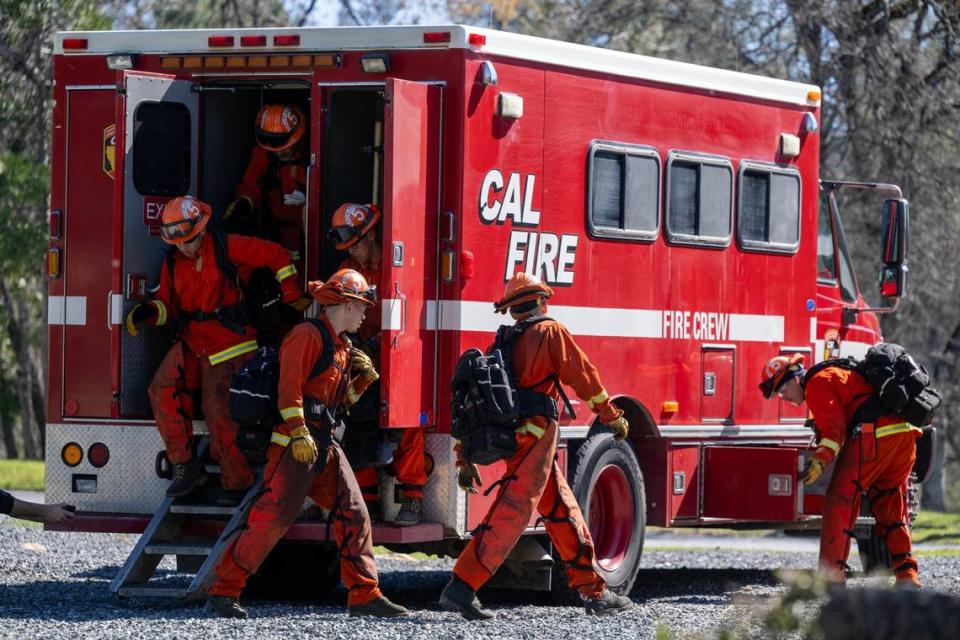California inmates fight wildfires — but if prisons can’t supply enough crews, what’s next?
California has long depended on incarcerated people to battle wildfires.
Since the end of World War II, the state has relied on inmates to staff its more than 200 “hand crews” deployed each fire season to lay hoses and help contain the blazes by cutting fire lines free of vegetation.
But a steady decline in the state’s prison population due to sentencing reform has left many of California’s minimum security conservation camps operating at half capacity or less. And as the 2024 fire season kicks into high gear, Cal Fire is short 110 of its 236 budgeted hand crews. Only 126 crews were fully staffed as of Thursday, the agency formally known as the California Department of Forestry and Fire Protection said.
“Hand crews are truly what extinguishes wildland fires,” said Erich Schwab, division chief for Cal Fire’s AEU sector, which responds to blazes in Sacramento, El Dorado, Amador and Alpine counties. “And we don’t have enough of those in the state right now.”
Most viable solutions to the hand crew shortage are far more expensive than inmate hand crews — a daunting prospect given the state’s estimated $45 billion budget problem.
But the California Department of Corrections and Rehabilitation hopes a new two-year pilot targeted at younger inmates will help revive the conservation camp model and boost the pipeline for hand crew laborers.
An expansion of CDCR’s existing “Youth Offender Program” allows qualified inmates under the age of 26 to serve their sentences in a conservation camp alongside trained inmate mentors. CDCR said the purpose of the program is to “promote rehabilitation and provide important job skills.” The program still excludes inmates who have a history of escape or are convicted of murder, arson or sexual assault.

The first group of 30 inmate participants and their mentors arrived at Growlersburg Conservation Camp in Georgetown last November. All came from Valley State Prison in Chowchilla, which claims to be leading the charge on implementing the more rehabilitative “California Model” of incarceration.
Capt. Fred Money, CDCR’s liaison for conservation camps, told reporters in March that inmate firefighters can “absolutely be hired by Cal Fire” after they leave on parole. Money said he “would be retired today” if it wasn’t for the camp program. He’s a firm believer in the power of the conservation camp model.
“I love this program, and there’s work that we can do with it still,” Money told reporters at Growlersburg camp. “Without a doubt, if there is a program within the state that can help somebody go from an incarcerated life to never coming back to an incarcerated life, this is the program that can do it.”
How does inmate shortage affect Cal Fire’s ability to fight wildfires?
Ten years ago, Schwab said he could order 20 hand crews for help and “no one would bat an eye.” But now, if he were to go to a wildland fire and try to call in help from 20 crews, the response he’d get is, “We don’t have them.”
Hand crews are teams of 15 to 20 firefighters who cut vegetation-free perimeters to prevent flames from spreading. They’re essential for steep terrain where bulldozers can’t safely go. After hiking several miles into a fire zone, crews use chainsaws and hand tools — such as Pulaski axes and McLeod rakehoes — to cut miles of fire line. Those borders help keep the blaze contained so other firefighters can extinguish the flames, often with water from miles of hoses that the hand crews are also in charge of laying out.
In January 2010, close to 4,000 people lived in California’s fire camps. As of early May, only 1,867 of the camps’ beds were filled.
Sentencing reforms in the past two decades, including credits for good behavior, decreased the inmate population even before the COVID-19 pandemic. The suspension of inmates into state prisons during COVID-19 continued the decline of available inmates for conservation camps.
“The administration currently projects that the state’s prison population will decline by roughly 7 percent between 2023‑24 and 2025‑26,” according to a February 2023 report from the Legislative Analyst’s Office. “These declines, should they materialize, likely would result in further reductions to the population housed at conservation camps.”
Given the shrinking incarcerated population, Gov. Gavin Newsom closed eight camps as part of the 2020-21 state budget. The closures reduced the total camp capacity to about 3,650 people and permanently cut 40 hand crews from CDCR’s ranks.
Of the 152 remaining crews, an average of just 56 were fully staffed and available for statewide response during the 2021 fire year. In 2022, only 48 of those crews were fully staffed. Today, though, the department had 69 crews staffed in the spring, according to spokesperson Tessa Outhyse.
The state also closed the California Correction Center in Susanville in 2022. The Susanville Training Center was responsible for training inmate firefighters for 14 of CDCR’s camps. The Sierra Conservation Center in Jamestown is now responsible for providing the majority of trained inmate firefighters.
CDCR has tried to triage the decline in fire camp populations by expanding eligibility to inmates who were traditionally labeled as higher risk. People with certain “violent” convictions, such as armed robbery or aggravated assault, could apply to live and work in a fire camp so long as they had a track record of good behavior and met other requirements such as education and physical fitness.

To make up for the decline in inmate firefighters, Cal Fire entered partnerships with the California Conservation Corps and the California Military Department to source more hand crews. Last year’s state budget approved close to $120 million and more than 500 additional positions for Cal Fire, the vast majority of them hand crews. Cal Fire also requested more than $100 million and 270 positions as part of the 2022-23 budget to staff hand crews from the California Conservation Corps and California Military Department
While CDCR inmate firefighters earn about $3 to $5 a day depending on skill level (and an extra $1 an hour when actively fighting fires), members of the California Conservation Corps and California National Guard earn upwards of $15 an hour. CDCR adopted new regulations April 16 that doubled wages for incarcerated workers — firefighters now earn roughly $6 to $10 a day, said CDCR spokesman Todd Javernick.
Cal Fire also now staffs three full-time hand crews of its own, Schwab said. That requires employing 120 firefighters, two battalion chiefs, 11 captains, seven engineers, several cooks and a staff services analyst.
The budget for all those Cal Fire salaries totals about $15 million.
“It’s a lot of money. An insane amount,” Schwab said. “It’s not a cheap fix, but it’s a fix.”
One silver lining of Cal Fire hiring extra crews is today’s inmate firefighters could have a greater chance of landing a seasonal job with Cal Fire after they parole.
“We’ve diversified our program a little bit recently because of the lack of inmates,” said Damon Godden, deputy chief for the hand crew program at Cal Fire’s Sacramento headquarters. “It turns out that by having our own firefighter crews, we’ve built an avenue for our parolees and ex-inmate firefighters to get jobs with us. So there’s a lot of benefits to us diversifying a little bit.”
What is life like for an inmate firefighter?
Tucked away in the woods, free of electric fences, barbed wire and guard towers, fire camps are an attractive alternative to traditional prison yards. Instead of wearing shackles and being escorted by guards, inmates at California conservation camps can walk around freely within camp.
For Branden Lee Lerma, Growlersburg is more than a colorful and nature-filled escape from the dull gray walls of prison. It also serves as a “safe space” where he’s “able to breathe for once.”
Lerma, 23, is from Winters and was was convicted of four felonies in February 2020, when he was just 19. The year before, Lerma participated in two separate robbery plots where he shot the victims, stole their possessions and abandoned them on the side of a road in Solano County. He pleaded no-contest to all four counts and was sentenced to 18 years in state prison.
Lerma said the robberies were “obviously” poor decisions, but at the time he was “going through a lot of traumatic events.” He said he had “hit rock bottom” and instead of seeking help, he allowed his environment and gang affiliations to control him.
He arrived at Growlersburg in November and has so far enjoyed his experience. When not on fire duty, Lerma and his fellow crew members work eight-hour days from 8:30 a.m. to 4:30 p.m. They assist with trail maintenance and restoration, facilitate prescribed burns and cut back overgrowth and foliage to improve visibility along major roadways.
“I used to hurt my community, and now I just want to give back,” Lerma said. “I’m tired of destroying. I want to build something with my hands.”
Lerma also hopes to shave time off his sentence through his service at the fire camp, although he said that wasn’t the sole reason driving him to Growlersburg. As part of Proposition 57, passed by California voters in 2016, inmates can accrue sentence credits by participating in rehabilitative programs. Those who work full-time in fire camps can shave time off their sentence. Lerma has already served four years in prison. He’s on track for parole in about five years, March 2029.
Once he leaves custody, Lerma hopes to find work as a seasonal firefighter for Cal Fire. But he also wants to share his own experience with at-risk youth in his home community and help them learn to manage their emotions and “just be better.”
If Lerma didn’t get into the Growlersburg camp pilot, he said he would’ve continued on with his programming at Valley State Prison. He had plans to become an “Offender Mentor” and work alongside certified counselors to facilitate substance use disorder treatment. He’s also on track to receive his associate’s degree in sociology from Lake Tahoe Community College later this year.
The only complaint about Growlersburg Lerma has so far, he said, is the size and quality of the lunch portions — a viewpoint that fellow firefighters and also camp leaders share.
“We need some more food,” Lerma said. “We get hungry.”
He described most lunches as a small sandwich — two pieces of white bread with a few slices of bologna — plus an apple. That’s not enough to sustain hours of hard manual labor, Lerma said, plus the hiking that the crews do to get to and from their assigned sites.
In his 14 years at Growlersburg, Camp Commander Lt. Michael Hill says he’s never blown the budget. But, this year, he was in the hole $20,000, largely due to food costs. Hill said he was expected to feed each firefighter on $4 a day, an allowance that Hill says hasn’t increased since the 1980s. That’s not enough money, in his opinion, to adequately feed a hard-working firefighter who’s burning hundreds of calories hiking, sawing and raking all day.
“We want the folks from (the Department of) Finance to see that four dollars is not sufficient. It’s not gonna get it done,” Hill said. “I’m not going to sacrifice the quality of food when my guys are out here working every single day.”

Advocates disagree on the ethics of California fire camps
Some advocates question whether inmates actually reap the benefits of fire training once they parole and are searching for jobs in the community. Anyone convicted of more than one felony is automatically banned from receiving an emergency medical technician license, and those with a single felony conviction must wait 10 years after release before they’re eligible.
A 2020 law created a path for former inmate firefighters to apply to expunge their records. But the expungement process is lengthy and difficult to navigate without support, said Amika Mota, a former inmate firefighter at the California Institution for Women who is now executive director of the nonprofit Sister Warriors Freedom Coalition. Firefighting jobs are also notoriously competitive, and ex-inmates are often competing with several other qualified candidates for Cal Fire and municipal jobs.
“We’re still really, really excluded from entering firefighting careers,” Mota said. “I just don’t feel like it’s always the most viable work for people who are reentering society.”
Additionally, Mota and other critics of the fire camp model argue that decarceration should be the priority, rather than continuing to expand access to the camps. If someone is low enough of a risk to go offsite and fight wildfires, Mota argues, there should be some questioning about whether that person should even be incarcerated.
“I have really mixed feelings, as somebody who loved the work that I did when I was incarcerated but 100% will not give an ounce of credit to prison for the change that I made in my life,” Mota said. “If we are deeming folks safe enough to working in the community, these people are safe enough to be home.”

Margot Mendelson, executive director of the nonprofit Prison Law Office, says conservation camps and other minimum security facilities have helped improve the quality of life for many of the clients her organization represents. While she and her organization are glad that inmates have the opportunity to live in lower-security settings, Mendelson pointed out that camps walk a fine line between providing rehabilitation through training and exploiting inmates for inexpensive labor.
“Asking people to risk their lives fighting fires for paltry wages is unconscionable and should not be tolerated,” Mendelson wrote in an email.
In contrast, Esteban Nuñez said he wishes he would’ve been eligible for fire camp when he was incarcerated. The current political strategist and lobbyist for the Anti-Recidivism Coalition was excluded from fire camp due to the severity of his convictions — manslaughter and assault. But after former Gov. Arnold Schwarzenegger famously commuted his sentence, one of Nunez’s first jobs out of prison was mentoring youth who were headed for the Pine Grove conservation camp. All of the youth mentees he’s talked to who have come home from fire camp have spoken highly of the program.
“I do think that fire camps, at least in my experience have really helped a lot of the people that I’ve seen come out of it,” Nuñez said. “They’ve come out with good heads on their shoulders.”
What will happen to California’s fire camps?
The future of California’s fire camps largely depends on whether CDCR can fill them and prove they’re worth funding even with a tight budget.
The Legislative Analyst’s Office has suggested the state continue shuttering or repurposing prison facilities as the inmate population continues to decline. Last year, the office recommended the Legislature reject a Newsom administration budget proposal to replace buildings at Growlersburg camp. And, earlier this year, analysts estimated the state could shut down five additional prisons and save $1 billion annually.
Mota said she would like to see fewer barriers for formerly incarcerated firefighters so they have a better chance at landing jobs after they leave prison. The Ventura Training Center for parolees is an intriguing solution that she hopes could provide a direct path to jobs for people after they leave fire camps. Above all though, Mota said decarceration should be the top priority. In particular, the idea of expanding access to inmates under the age of 26 feels “sticky and uncomfortable” to her.
“I don’t think CDCR is the right entity to be holding our young folks,” Mota said.
She fears the state might use understaffed Cal Fire crews as a justification for keeping low-risk inmates in prison rather than allowing them to return to their communities.
“We are not free. Even though we can see the trees and breathe the air, and yes that’s a blessing compared to those cement walls we’re used to, it’s not freedom,” Mota said. “It’s a step in that direction, but it’s not freedom.”
On the other side, Nuñez believes fire camps present the ultimate opportunity for restorative justice. Allowing inmates to protect their communities from wildfires, as well as perform rescue operations and maintain public lands, gives them “a different understanding of what it means to protect your community,” Nuñez said, “and on the flip side, what it means to harm your community.”
Even though the state has come a long way since he got out of prison, Nuñez wants to see more pathways open for parolees to secure firefighting and forestry jobs. He also hopes state lawmakers continue fully funding and supporting the fire camp program.
“It provides hope that somebody partaking in this program can do enough to be accepted back into the community, right? To do enough, to prevent enough harm, that it can make up for the harm they caused. That helps rid people of their shame, and it allows people to be the best versions of themselves.”


